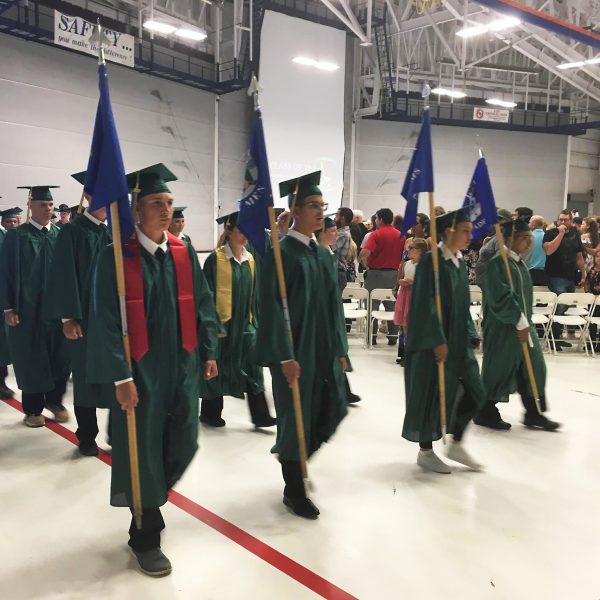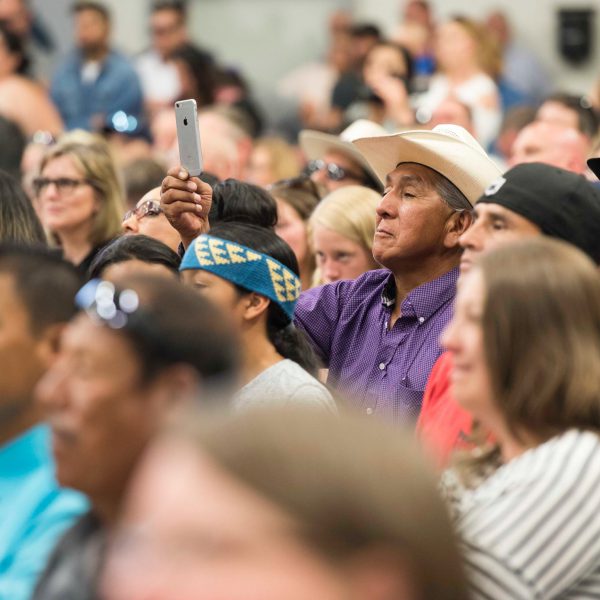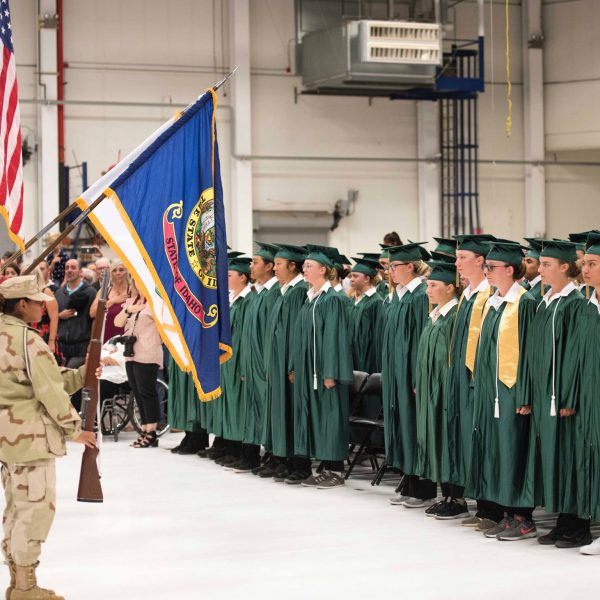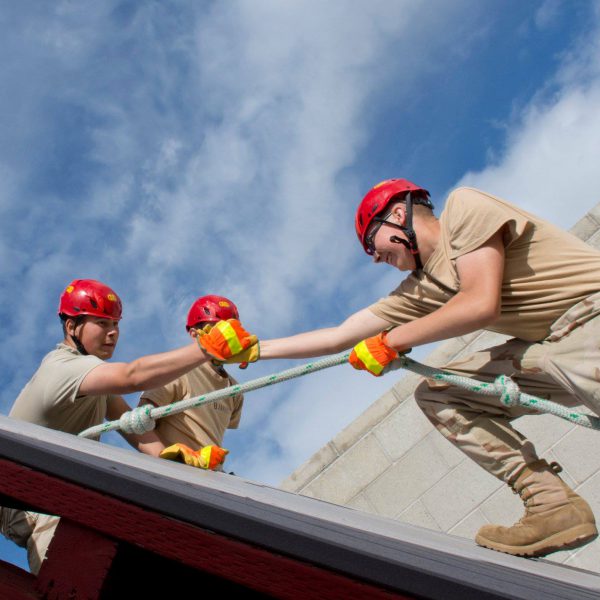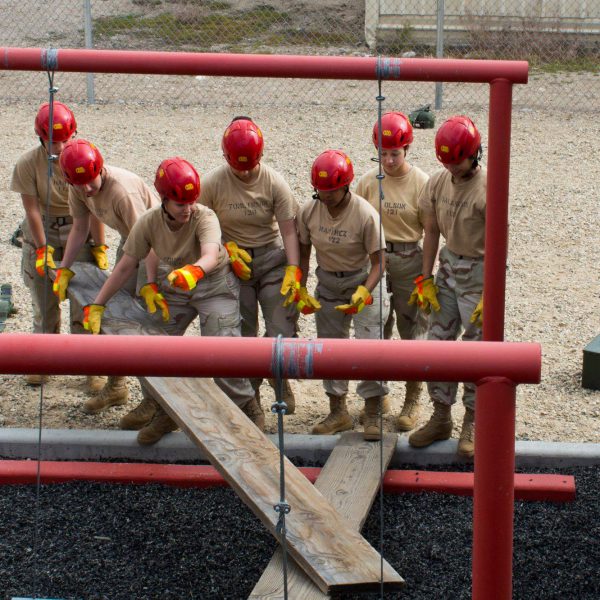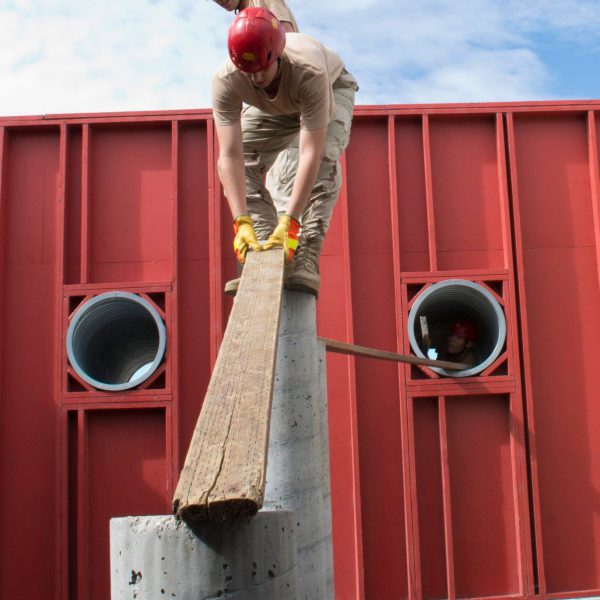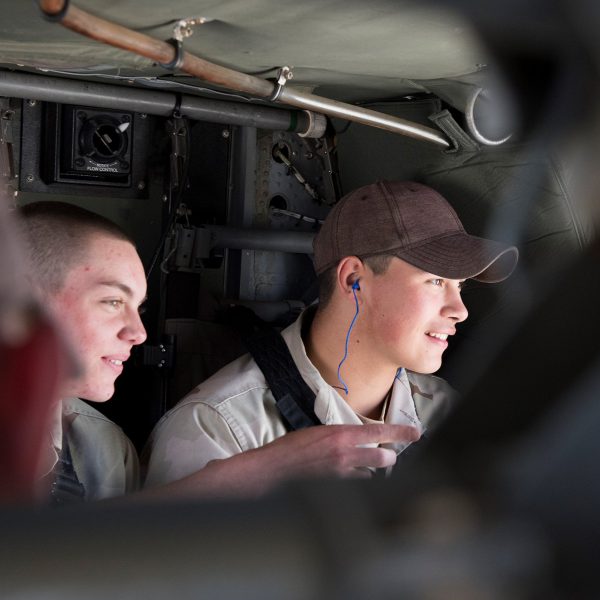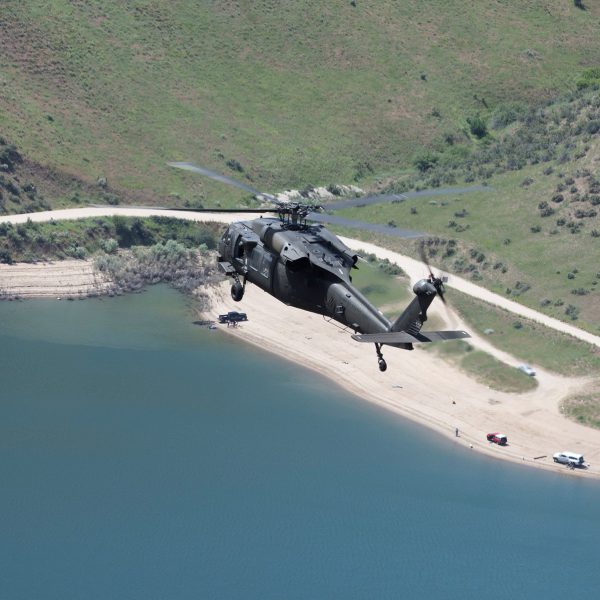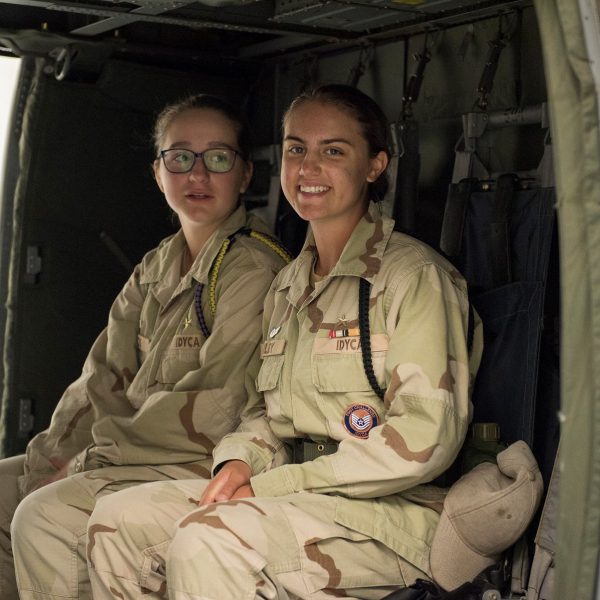Category: Archived
ASOS Airmen Preparing and Training for State Emergency Response
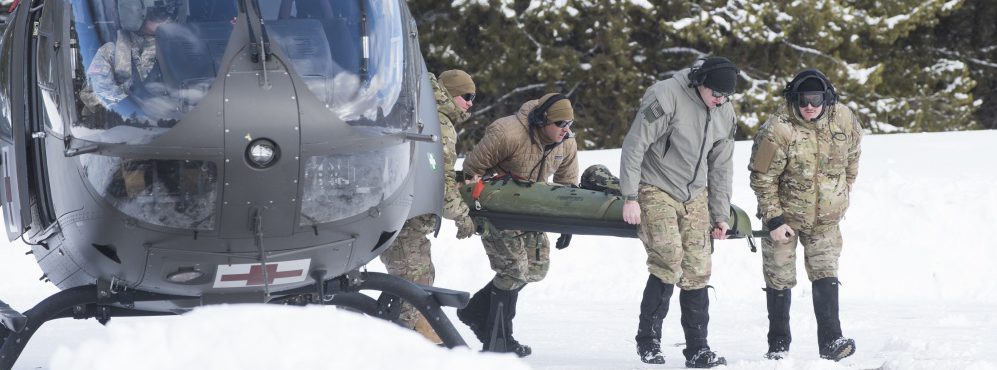
BOISE AIR TERMINAL AIR GUARD STATION, ID
03.08.2018
Story by Master Sgt. Becky Vanshur
CASCADE, Idaho – Envision a scenario where the crash of an avalanche has left several people missing, or you are skiing in the mountains and lose sight of your buddy. Visualize it’s you that is lost off-trail, hoping to be rescued, waiting for the sound of helicopter blades pulsating in the air or the sound of voices ahead. This is the mission of search and rescue teams – to find you.
In an effort to begin rescue missions with civilian and state entities, Idaho’s 124th Air Support Operations Squadron (ASOS) conducted its first-ever training event that involved approximately 70 civilians from local rescue teams in Cascade, Idaho, March 1-4, 2018. The goal for this integrated training was to take the skills used in the federal mission and apply those capabilities for the Defense Support of Civil Authorities (DSCA).
“I feel like we are moving into a domestic operations concept. We’ve been at war for a long time, we’ve been deploying for a long time, we want to enlarge our footprint,” said 1st Lt. Jason Waites, 124th ASOS, officer in charge of operations. “We want to roll into the DSCA and establish the ASOS as a state entity.”
The Idaho Air National Guard’s ASOS, specifically the Tactical Air Control Party (TACP) Airmen, have endured intense physical, mental and technical training. They are experienced in extensive outdoor training, survival skills, Rough Terrain Evacuation Course, Wilderness First Responder training, and mountain warfare. Additionally, they have the equipment available for helping with search and rescue missions.
“This training for us is like a proof of concept that we will be able to advertise our capabilities to the state, that this is what we have the ability to do. When that emergency goes out, we can come to help. TACPs from neighboring states have pre-packaged communications systems set up and have helped with mudslides and fires because of the night vision and thermal capability of finding people in the dark,” said Chief Master Sgt. Mike Furman, chief enlisted manager of ASOS. “These other states have coordinated helicopter landing zones, helped with post hurricane and flood response already. Although we haven’t been called upon yet, we just want to make sure we are ready for when the call comes.”
The goal of this joint engagement was to work alongside civilian authorities during avalanche rescue training, snowmobile training, sling load training, and stretcher hoist rescue training, along with the Idaho Army National Guard 1-183rd Aviation Battalion’s UH-72 Lakota Rescue Helicopter.
“We weren’t really aware, until today, how accessible you guys [ASOS] were,” said Dan Corsberg, Garden Valley Fire Department. “To know it could be an hour, hour and a half, for you guys to be on scene. That really does change the equation for us, a lot. That has been the biggest take-away for us with this training.”
Local civilian search and rescue teams present for this joint training included: the McCall Police Department, McCall Fire Department, Cascade Fire Department, Donnelly Fire Department, Garden Valley Fire Department, Valley County Search and Rescue, Valley County Sheriff’s Office, Boise County Sheriff’s Office, Adams County Sheriff’s Offices, Bogus Basin Ski Patrol, Brundage Ski Patrol, Tamarack Ski Patrol, Idaho Fish and Game, and the U.S. Forest Service.
The training was focused on everything from search and rescue, to command and control, to effectively testing communications. When it comes to the Federal Emergency Management Agency, there are Emergency Support Functions (ESF). ESF number nine is search and rescue related, and ESF number two is communications. This exercise effectively tested command and control with air-to-ground and ground-to-ground communications.
“These guys know what they are doing, and it’s been great. We are all learning from each other. This is an incredible opportunity,” said Jim Pace, Valley County Search and Rescue.
Col. Scott Sheridan assumes command
BOISE, Idaho
Jan. 8, 2018
Story by Capt. Robert Taylor
Idaho Army National Guard
The Idaho Army National Guard’s 116th Cavalry Brigade Combat Team held a change of command ceremony Jan. 7 on Gowen Field to signify the transfer of authority between outgoing commander Col. Farin Schwartz and the incoming commander, Col. Scott Sheridan.
Schwartz assumed command of the state’s largest unit in March 2016. He said that his time as the brigade’s commander flew by.
“I’m thankful for the dedication and hard work of the Soldiers who made the last two years the highlight of my career,” Schwartz said.
Under Schwartz’s command, the 116th Cavalry Brigade Combat Team participated in several operations across the world and underwent a transition that saw the brigade grow by several hundred Soldiers and incorporate a unit from the Nevada Army National Guard.
In the summer of 2016, the brigade participated in Saber Guardian 2016, a multinational military training exercise that involved 2,800 military personnel from 11 countries in Cincu, Romania. More than 1,100 116th Cavalry Brigade Combat Team Soldiers participated in the exercise, which involved using trains, ships and convoys to move more than 500 pieces of equipment to the training site, more than 9,000 miles away from Boise.
Among other exercises, the unit also participated in Maple Resolve, the Canadian Army’s premier brigade-level validation exercise in Canada; Keris Strike 2017 in Pahang, Malaysia; and Key Resolve in South Korea.
Domestically, the brigade participated in staff exercises at Joint Base Lewis-McChord outside of Tacoma, Wash., and at Fort Indiantown Gap, Pa.
In addition, the brigade’s engineer battalion spent last summer at Fort Hood, Texas, providing opposing forces in support of the 278th Armored Brigade Combat Team’s eXportable Combat Training Capability rotation. The task force provided opposing forces that allowed the Tennessee Army National Guard unit to train against a capable near-peer force.
The brigade’s 2016 reorganization brought updated equipment and 200 additional positions for Idaho Soldiers and expanded the unit’s footprint into Nevada.
The 2-116th Cavalry Regiment, headquartered in Caldwell, transitioned from an armored reconnaissance squadron to a combined arms battalion; the Magic Valley’s 116th Brigade Special Troops Battalion reorganized into the 116th Brigade Engineer Battalion and added a forward support company in Jerome and a second engineer company in northern Idaho; and in eastern Idaho, the 1-148 Field Artillery Battalion added an additional firing battery.
The Nevada National Guard’s 1-221st Cavalry Regiment and the 777th Forward Support Company also joined the brigade.
The brigade now consists of more than 4,000 Solders in nearly 20 Idaho communities and four states, as Montana and Oregon each contribute a combined arms battalion to the brigade.
“It’s not what I did,” Schwartz said. “It’s what we did across four states.”
Sheridan previously served in the brigade as the commander of the 2-116th Cavalry Regiment from January 2016 to February 2017. His last assignment was the director of operations, Idaho Army National Guard,
before he assumed command of the brigade.
Sheridan has served in the Idaho Army National Guard since 1997. He enlisted into the Oregon Army National Guard in 1987 and commissioned as an armor officer in 1990 after graduating from Eastern Oregon State University’s ROTC Program.
“It’s an enormous responsibility to ensure every member of the organization is always preparing for the future,” Sheridan said. “It’s also critical to ensure every member of the brigade understands that they are just as important as the Solider to their left or right and that we watch out for each other.”
Schwartz will now serve as commander, Idaho Army National Guard/Assistant Adjutant General – Army as Brig. Gen. John Goodale prepares for retirement.
STARBASE Grand Opening

A S.T.E.M. Beginning
The Idaho National Guard held a grand opening ceremony for Starbase Idaho at Gowen Field, Boise, Idaho on Aug. 31, 2018. The Department of Defense Starbase program is designed to motivate students, primarily socio-economically disadvantaged fifth graders, to explore more education in science, technology, and math areas of study.
Lt. Gov. Brad Little, lieutenant governor for the state of Idaho, and Michael J. O’Toole, Department of Defense director, civil-military programs, cut a ceremonial ribbon during a grand opening ceremony.
Lt. Gov. Brad Little, Michael J. O’Toole, Brig. Gen. Michael Garshak, the adjutant general of Idaho and commander of the Idaho National Guard, and Jim Heuring, the director of Starbase Idaho, speak to a crowd of soldiers, Airmen and civilians after the ribbon cutting ceremony of the Starbase Idaho buildings.
Get to know: Capt. Adam Rios

From the streets to the military ranks: How his service changed his life
IDAHO ARMY NATIONAL GUARD, UNITED STATES
01.08.2019
Story by 2Lt. Crystal Farris
As a homeless kid, Idaho Army National Guard Capt. Adam Rios broke into an abandoned building in Utica, New York, where he found an old cigar box. Inside the box were various small bars with different colored stripes on one side and pin clasps on the other. One particular pin caught his eye. It had two adjacent bars like railroad tracks. Thinking it was cool, Rios affixed the pin to his hat, which he wore for a while after.
“Years later, I was already in the military, walking down a hall and came across that same looking pin on an Army poster,” said Rios. “The pin was a captain’s rank. In that box I had found someone’s old military awards and rank and thought ‘wow, that’s what I was wearing 10 years ago and now it’s come back to me full circle.’”
Rios grew up on the streets where he was in trouble with the law, ate what he could steal and slept where he could find shelter. At that time he could not imagine making it to his 20th birthday, let alone one day serving in the military.
Today, Rios is a 39-year-old captain in the Idaho Army National Guard where he serves as the commander of Headquarters and Headquarters Company, 116th Cavalry Brigade Combat Team. He works fulltime as a security officer for the Idaho National Laboratory’s Naval Reactors Facility and lives in Shelley, Idaho, with his wife and four children.
The path to get there was not always easy, however, Rios credits each of his experiences to the man he has become.
“The military was the smartest thing I could have done,” said Rios. “It changed me from a little hoodlum, to someone who could take charge of my life, pay my own bills and go to school.”
In the beginning
Before he was homeless and joined the military, Rios was a troubled kid from a poor family. His addict father was abusive and his mother was depressed. When his parents divorced, Rios stayed in Utica with his father while his two sisters went to live with their mom in Pocatello, Idaho.
When his father abandoned him, Rios tried to survive as a nine-year-old alone on the dangerous streets of New York. From a large Puerto Rican family, he sometimes had a warm couch of a distant family member to sleep on.
Eventually, one of his older cousins called the state’s protective services and Rios was put into foster care. His foster parents taught him about life and being honest, he said. It was the first time he had a positive parental influence.
“They loved me, took care of me and provided me with the information I needed to become a good person,” said Rios. “It didn’t set in right away and I wasn’t a perfect kid overnight, but everything they taught me had some impact on my life later down the road.”
Within a few years he moved back with his father who had cleaned up, yet Rios could not escape his own familiar past. Continuing to get into trouble, he finally decided to leave New York and all its negative influences.
At 19 years old, Rios went to visit his mother and sisters who were still living in Idaho. He never left. The next year he enlisted into the Idaho Army National Guard as a 13T field artillery surveyor.
However, he did not join for the service to his country or even the money, he said, but instead because his step-father told him only strong people could handle such a challenge. The challenge was more difficult than Rios predicted and he barely made it through his first year in the military.
“I thought I was the man,” said Rios. “I had a huge attitude and felt entitled. Nobody could tell me nothing. I thought I knew everything and they knew nothing. Basic training was a horrible experience, along with my first years in the military.”
It was not until he deployed to Iraq with the 116th Cavalry Brigade Combat Team in 2004 that his life and perspective changed. There Rios found himself surrounded by fellow Soldiers who were scared to death, he said, because they had never been deployed before.
A defining moment
“I grew up in hell,” said Rios. “In a place where my life was already threatened so I was not at all intimidated by the deployment like others were.”
There to train the Kurdish Army, he felt comfort working alongside the people who he identified with because of their similar misfortune and poverty he suffered while growing up.
One day while disposing of food waste at a local dump site consisting of holes dug out of the sand, his team saw a mother and two young children emerge from one of the holes. As they began scavenging the garbage for food scraps, he thought how fortunate he was in comparison.
“I thought then that I hadn’t gone through anything,” said Rios. “As horrible as my upbringing was, I am not living in a hole in a dump. That deployment shaped my life and that’s when I knew I wanted to help people and be in the military forever.”
Rios reevaluated his life upon returning home from deployment and considered how fortunate he was to have the benefits and opportunities the military provides him.
Rios decided he could help people by becoming a counselor. He enrolled at the Idaho State University where he earned a bachelor’s in sociology and later worked as the program director for Tueller Counseling agency until taking his job at the Idaho National Laboratory.
“Although I didn’t join originally for the right reasons, I came to appreciate my choice later in life,” said Rios. “The military paid for my schooling, provided my with the VA loan I used for the house I live in and is preparing me for my future retirement.”
With college complete, Rios turned in his staff sergeant rank and commissioned as second lieutenant through the Idaho Army National Guard’s accelerated Officer Candidate School program in 2009. A year later he completed Basic Officer Leaders Course as a 13A field artillery officer.
A changed man
“I wanted to lead and do the best good I could,” said Rios.
In 2010, he deployed again with the 116th Cavalry Brigade Combat Team, however, this time as a first lieutenant responsible for the safety of his Soldiers.
“I had to take care of myself since the age of nine,” said Rios. “But, that was nothing compared to the pressure I felt as a brand new lieutenant responsible to bring everyone home alive.”
During the deployment he gained leadership experience as a new officer and commander of a security detail responsible for escorting VIPs throughout Iraq. It was a steep learning curve, he said, sometimes learning lessons the hard way but in the end his unit returned home without a single fatality.
“The lessons I experienced early in my officer career shaped what kind of leader I wanted to be,” said Rios. “My command today and desire to see Soldiers succeed is a direct result of that deployment.”
Rios took command of HHC, 1-116th Cavalry Brigade Combat Team in November 2018 and has since worked diligently to improve unit readiness and the morale of its Soldiers. He has done so by implementing programs such as “Return to Readiness” that focuses on Soldier fitness and health through counseling and training.
“My background helps me understand we all have lots of experiences that make us who we are,” said Rios. “Sometimes people need a chance to make the right choices. My foster parents took the time on me when I really wasn’t deserving and it turned out positive. I try to emulate that and lead from an honest place, hopefully imparting something on my Soldiers that will help them succeed.”
Back to the Newsroom
JOIN THE IDARHO ARMY NATIONAL GUARD
IDYCA Grad

GRADUATION TIME FOR The Idaho Youth ChalleNGe Academy!
Graduation time for the Idaho Youth ChalleNGe Academy! One Hundred and Elven Cadets are graduating this weekend from the academically and physically rigorous 22-week program-the Academy’s ninth class-bringing the total number of IDYCA graduates to 874. Roughly 300 16-18 year-olds apply to attend each Academy class, which have been held twice a year since January of 2014. Academy graduates have gone on to attend college, participate in Job Corps, complete vocational education, and join the US Military, including one graduate who participated in the Presidential Inauguration Air Force Honor Guard.
However, before commencement, the Idaho National Guard gave them the ride of their lives today aboard Idaho Army National Guard UH-60 “Blackhawk” helicopters. Cadet’s from the ninth class also applied the skills they’ve learning in leadership, followership and communication while taking on the Leadership Reaction Course.
Congratulations Class 18-1! Go forward and do great things!
 Official Government Website
Official Government Website
